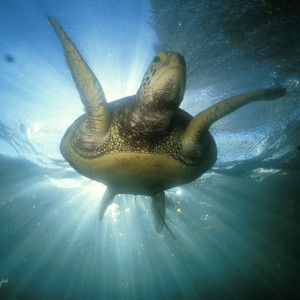Bermuda Green Turtles: Back From Brink
 The goal of the Bermuda Turtle Project — now entering its 43rd year – is, “to promote the conservation of marine turtles through research and education”.
The goal of the Bermuda Turtle Project — now entering its 43rd year – is, “to promote the conservation of marine turtles through research and education”.
Under the direction of Bermuda’s Aquarium, Museum & Zoo, the project team has made notable progress to date and continues to expand its research and education objectives.
Fished almost to the brink of extinction, the green turtle — while still endangered – is the most common sea turtle in Bermuda’s waters. Green turtles once nested abundantly on our beaches. “Sea Venture” survivor William Strachey’s narrative of 1610 noted “even then the Tortoyses came in again, laying their eggs (of which we should find five hundred at a time in the opening of a shee turtle) in the sand by the sea shoare.”
New World explorers wrote of huge herds of turtles in Bermuda. The explorers would capture many of the turtles, which were capable of remaining alive for weeks in the holds of their ships, providing fresh and nutritious meals for their long ocean voyages.
In 1610, settlers noted that “on the shores of Bermuda, Hogges, Turtles, Fish and Fowle do abound as dust of the earth.” With recorded takes of more than 40 turtles per boat per day, it was not long before the local stocks of sea turtles were noticeably depleted.
In 1620, only 11 years after Bermuda’s colonisation, an act of the Bermuda Assembly against the killing sea turtles was passed. This may well be the New World’s first written conservation legislation. In spite of this early protection of young turtles, larger turtles were fished until 1973.
The Bermuda Turtle Project has pointed out if our forefathers knew then what we know now — that sea turtles take up to fifty years to reach maturity — then they surely would have protected turtles of a larger size and our nesting population may not have become extinct in the early 1800s.
In an attempt to reestablish a nesting population in Bermuda, more than 25,000 green turtle eggs were transplanted from Costa Rica in the 1960s and ’70s by the Sea Turtle Conservancy and buried on beaches in Bermuda. More than 16,000 of these eggs hatched. Knowing that turtles return to the beach on which they were born to lay their eggs, it is hoped that these animals will eventually return to reproduce in Bermuda.
No means of determining age in sea turtles has been perfected, but scientists believe that it takes up to 50 years for a green turtle to reach sexual maturity. If this is the case, turtles could arrive to recolonise Bermuda any time within the next 20 years.
Studies were made on the behaviour of these hatchlings by Jane Frick. She found that, upon release, the hatchlings all took a direct course to the southwest away from the island and out into the open ocean. This work heightened local awareness and led to further legislation in 1973. Since that time, all sea turtles have been completely protected locally.
The Bermuda Turtle Project was initiated in 1968 by Dr. H. Clay Frick II, Trustee of the Sea Turtle Conservancy, in cooperation with the Bermuda Government.
Since Dr. Frick’s retirement in 1991, the project has been under the direction of the Bermuda Government Aquarium, Museum and Zoo, in collaboration with the Sea Turtle Conservancy. The Bermuda Turtle Project is actually funded by the non-profit BZS, which is the support charity for the Aquarium.
The shallow reefs and turtle grass flats of Bermuda provide excellent grazing areas for the green turtles that are the main subject of this research project.
The turtle tagging project is one of the longest-running projects of this kind in the world. It has developed into a multi-faceted study of sea turtles. The primary aim of the Bermuda Turtle Project is to fill in critical information gaps in the life history of the green turtle and to make that information available to professionals and lay people alike.
Read More About
Category: All, Environment, News


Wonderful news . . . The late Dr. Clay Frick would be so pleased that the turtle project worked!
so when will we see them back on the local menus?
Good news!!! Congrats to all who have worked on this project!!! A job well done…Keep up the good work!!!
GREAT NEWS KEEP THE GREAT WORK UP!!!!!